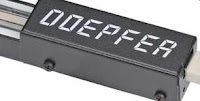 Module A-138 is a simple four channel mixer that can be used for either control voltages or audio signals. (although i hardly ever use one for CV)
Module A-138 is a simple four channel mixer that can be used for either control voltages or audio signals. (although i hardly ever use one for CV)Each of the four inputs has an attenuator, and a master attenuator, so that the mixer can be used to interface directly with an external mixer, amplifier, etc.
There are two versions of this module:
A-138 a: potentiometers with linear response, especially suitable for control voltage mixing.
A-138 b: potentiometers with logarithmic/exponential response, especially suitable for audio signal mixing.
The latest version from April 2004 is an improved version of the module A-138b.
For the revised versions control In1 works as a DC offset generator (about 0...+5V) provided that no patch cord is plugged into socket In1.
If this feature is not required it can be deactivated by removing a jumper on the pc board.
In the summer 2004 the A-138a was introduced with this improvement.
In the summer of 2007 Doepfer also released a mix expander module A-138x, that increased the number of inputs of the A-138 by five.
That module was discontinued last year...












